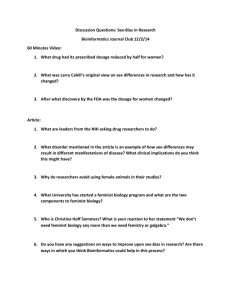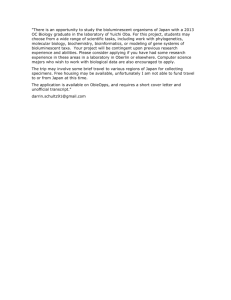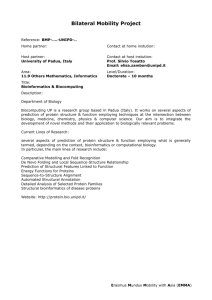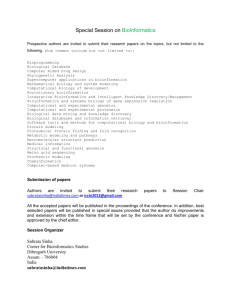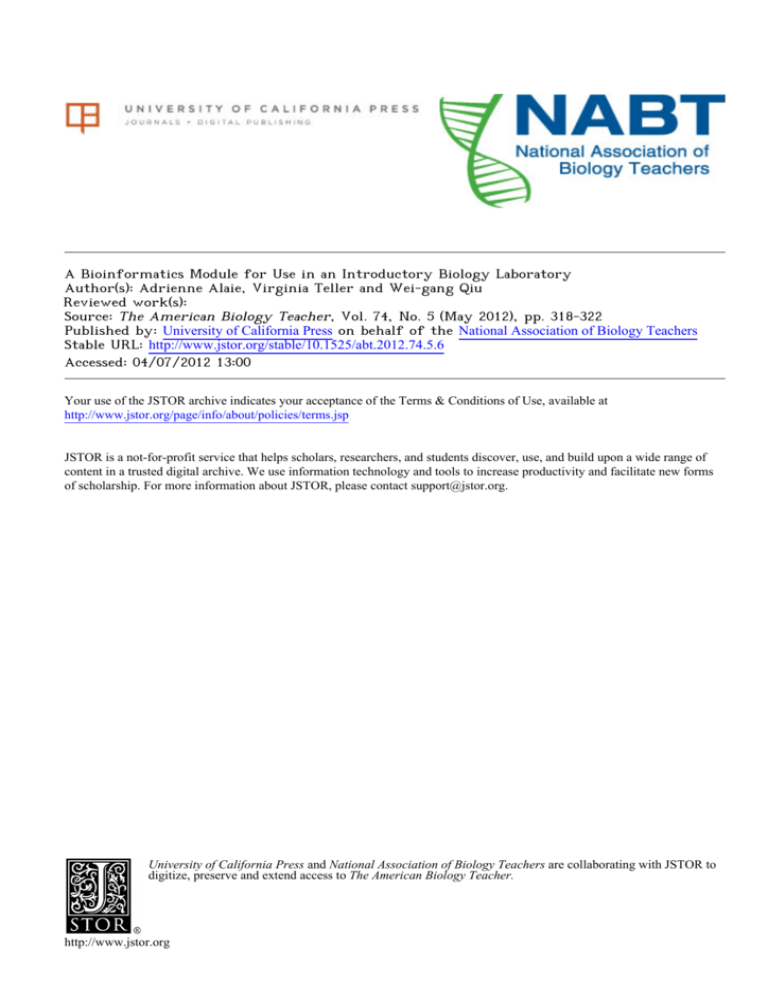
A Bioinformatics Module for Use in an Introductory Biology Laboratory
Author(s): Adrienne Alaie, Virginia Teller and Wei-gang Qiu
Reviewed work(s):
Source: The American Biology Teacher, Vol. 74, No. 5 (May 2012), pp. 318-322
Published by: University of California Press on behalf of the National Association of Biology Teachers
Stable URL: http://www.jstor.org/stable/10.1525/abt.2012.74.5.6 .
Accessed: 04/07/2012 13:00
Your use of the JSTOR archive indicates your acceptance of the Terms & Conditions of Use, available at .
http://www.jstor.org/page/info/about/policies/terms.jsp
.
JSTOR is a not-for-profit service that helps scholars, researchers, and students discover, use, and build upon a wide range of
content in a trusted digital archive. We use information technology and tools to increase productivity and facilitate new forms
of scholarship. For more information about JSTOR, please contact support@jstor.org.
.
University of California Press and National Association of Biology Teachers are collaborating with JSTOR to
digitize, preserve and extend access to The American Biology Teacher.
http://www.jstor.org
I n q u i r y & A Bioinformatics Module for
I n v e s t i g at i o n s Use in an Introductory Biology
Laboratory
A d r i e n n e A l a i e , V i r g i n i a T e l l e r,
Wei-gang Qiu
Abstract
new bioinformatic ways of thinking derived from the fields of computer and information sciences.” In recognition of this reality, the
curricular initiative at Hunter was undertaken by a diverse team
of faculty from the departments of biology, chemistry, computer
science, mathematics, and statistics. Courses selected for inclusion in this initiative range from large introductory-level classes
to small upper-level electives. The introductory courses enroll a
wide range of students, including traditional science majors, post­baccalaureates, and students with no professed interest in the
­sciences. Thus, a heterogeneous population of students is exposed
to the field of bioinformatics and the principles of quantitative
biology as a consequence of this project.
To introduce the curricular initiatives, Hunter’s team integrated
Key Words: Bioinformatics; undergraduate; inquiry-based learning;
innovative exercises across many courses that employed both active
active learning; BLAST.
and cooperative learning. Where possible, real-world illustrations
were used for student explorations because authenticity of data serves
to increase the interest and enthusiasm of students (Campbell, 2003).
In response to biomedical science becoming increasingly dataintensive, Hunter College, like other undergraduate institutions The bioinformatics module presented here is the first example of an
exercise suitable for an introductory biology
(Miskowski et al., 2007), has implemented
course with a sizable non-science populaa curricular initiative designed to equip stution.1 This real-world, inquiry-based exercise
dents in biology and related sciences with
Familiarizing students with
basic skills in computational and quantitative
is designed for use in a single 90-minute class
bioinformatics – the use of
biology. Familiarizing students with bioinforperiod. It is readily adoptable by educators who
matics – the use of computers to investigate
wish to include bioinformatics content without
computers to investigate
and analyze biological data – lays the founsignificantly reworking an existing syllabus.
and analyze biological data
dation for more advanced work in the bioData collected from 2 years of implementamedical sciences. According to the findings of
tion demonstrate that students who complete
– lays the foundation for
the National Research Council’s 2003 report
this module understand how to read files in a
Biology 2010: Transforming Undergraduate
biological database (GenBank) and how to use
more advanced work in the
Education for Future Research Biologists, the
a research tool (BLAST) to mine the database.
biomedical sciences.
adequate training of students necessitates a
Further, students’ responses suggest that, like
multidisciplinary approach. Donald Kennedy
other inquiry-based assignments, this exercise
notes that “the 2010 report recognizes – as
1
The bioinformatics module developed by Bednarski et al. (2005) was integrated into
many biologists have not – the reality that our discipline has been
the
third semester of a 3-semester introductory course. The students in that course
­transformed into an interdiscipline” (Kennedy & Gentile, 2003).
have completed Organic Chemistry I and are taking Organic Chemistry II concurrently.
Rice et al. (2004) add that “in addition to being able to think about
Hunter’s BIOL 102 has no chemistry prerequisite. Other published bioinformatics
biological processes from molecular to organismal and community
modules were developed for and integrated into upper-level undergraduate or
levels of organization, tomorrow’s biologists will also benefit from
graduate-level biology courses (Feig & Jabri, 2002; Honts, 2003; Kumar, 2005).
Since biomedical science has become increasingly data-intensive, acquisition
of computational and quantitative skills by science students has become more
important. For non-science students, an introduction to biomedical databases
and their applications promotes the development of a scientifically literate population. Because typical college introductory biology laboratories do not include
experiences of this type, we present a bioinformatics module that can easily be
included in a 90-minute session of a biology course for both majors and non­majors. Students completing this computational, inquiry-based module observed
the value of computer-assisted analysis. The module gave students an understanding of how to read files in a biological database (GenBank) and how to use
a software tool (BLAST) to mine the database.
The American Biology Teacher, Vol. 74, No. 5, pages 318–322. ISSN 0002-7685, electronic ISSN 1938-4211. ©2012 by National Association of Biology Teachers. All rights reserved.
Request permission to photocopy or reproduce article content at the University of California Press’s Rights and Permissions Web site at www.ucpressjournals.com/reprintinfo.asp.
DOI: 10.1525/abt.2012.74.5.6
3 18
The american biology teacher
volume 74, No. 5, May 2012
provides “the self-investment and excitement that comes with discovery of new knowledge” (Brame et al., 2008).
Setting
JJ Hunter College of the City University of New York is a 4-year college in the heart of Manhattan with an undergraduate population
of ~15,500 students. Among the graduation requirements is a twocourse natural science sequence, which students often satisfy during
their freshman or sophomore years. Principles of Biology I and II
(BIOL 100 and 102) are routinely selected by non-science students
to satisfy this requirement. In addition to non-science students,
however, BIOL 100/102 are also taken by biology and other natural
science majors as well as by post-baccalaureates fulfilling prerequisites for graduate and medical school. This module was developed
for BIOL 102 to introduce the field of bioinformatics to this heterogeneous population, with the knowledge that this is likely to be
the only exposure to bioinformatics the non-science students in the
course would experience.
Profile of Students in BIOL 102
(Spring 2010)
JJ Post-baccalaureates made up ~25% of the 453 students in BIOL 102
in spring 2010. Undergraduate enrollment that term (~75%) was 17%
freshmen, 28% sophomores, 24% juniors, and 6% seniors. Of these
undergraduates, ~20% were intending to major in biology, 18% psychology, 10% biochemistry, 9% medical lab sciences, 8% pre-med,
2% pre-health sciences, and 2% chemistry.2
Fifty-seven percent of the students had been exposed to the field
of bioinformatics in previous coursework, likely BIOL 100;3 10%
had heard about it but had never performed any exercises; and 26%
had never heard of bioinformatics.
The Assignment: General Description
JJ The exercise introduces BLAST (Basic Local Alignment Search Tool;
Altschul et al., 1990), one of the most widely used bio­informatics
programs. Casey (2005) states that a “testament to the broad applicability of BLAST in the bioinformatics community” is the fact that
the original paper (Altschul et al., 1990) “was one of the most highly
cited papers published in scientific literature in the 1990s.”
The exercise, which begins on paper and progresses to the computer, was designed for a single 90-minute laboratory period. It
applies basic molecular biology but assumes no previous knowledge
of bioinformatics. Students do not have access to the entirety of the
module at the beginning of the lab session; instead they complete the
exercise in three parts, receiving successive installments from their
instructors upon completion of preceding segments. Guiding the
inquiry by parsing out information allows for gradual development
of ideas and promotes collaborative exploration as students examine
questions and formulate answers without the aid of search engines.
The paper portion of the exercise asks each student to locate a
30-character segment within a human DNA sequence (the identity
of which is withheld) of As, Ts, Gs, and Cs, ~3300 characters long.
Scanning the sequence by eye affords students a small degree of
insight into BLAST’s power, in that it takes many students 10–15
minutes to complete the scan, even for such a limited sequence. Two
different sequences are used so that each student within a pair has an
opportunity to search for his own sequence. A natural competition
broke out between students within a pair to see who could successfully locate the sequence first. This immediately engaged students in
the exercise.
Following completion of the paper portion, students continued
to work in pairs to complete the computer portion of the exercise.
With 12 computers for 24 students, the pairing was practical but not
a necessity, given that the module could have been run twice during
the 3-hour lab period. When pairs of students exhibited collaboration and cooperation in answering the questions on the worksheets
during the first implementation of the module, the students were
paired off in subsequent semesters to encourage group learning. The
computer portion acquaints students with GenBank and instructs
them to apply BLAST to search GenBank for a match against an
unknown DNA sequence.4 Students test fragments of differing
lengths and sequence complexity as a means of introduction to the
limitations of BLAST and are then asked questions about the DNA
match returned by the search. Finally, students widen their search to
compare their sequence against additional nucleotide databases and
answer questions about their findings.
Assessment
JJ Graduate students and post-baccalaureates serve as the laboratory
instructors for BIOL 102. With each lab section accommodating up
to 24 students, as many as 15 instructors may be on staff at any one
time. With a goal of uniformity of rigor across the sections, the module
developers, rather than the instructors, wrote both the postmodule
and examination questions and provided comprehensive grading
policies to standardize the scoring of the students’ responses on these
assessment tools.
Assessment following the first implementation of the module
in spring 2009 (n = 20) was encouraging;5 therefore, the scope of
the assessment was expanded in 2010, to include sections taught by
four different instructors (n = 78). The students fared very well on
both assessment tools: an average of 92% on the questions that were
administered during the lab period within minutes of completion of
the module (“Post_Module”), and 88% on an examination question
measuring understanding and retention 1 week later (“Week_later”),
scoring equivalently on both assignments (Wilcoxon test, P = 0.34;
Figure 1). Thus, students as a cohort seemed to retain the information they learned from performing the module and apply their newly
acquired knowledge 1 week after the bioinformatics module was
completed. Individually, however, students’ grasp of bioinformatics
content weakened significantly after 1 week (paired Wilcoxon test,
P = 0.0074). Although expected, the diminished retention suggests
room for future enhancement and improvement in module design,
implementation, or both.
This DNA sequence is the same sequence the students just searched by eye. BLAST
reveals that this sequence codes for the fragile-X mental retardation protein (FMRP).
5
One section (n = 20) was selected for assessment in spring 2009. The students earned
an average of 82.5% on the postmodule questions and 80% on an exam question 1
week later.
4
Many students did not select any of the seven possible majors provided on the
questionnaire.
3
Hunter College’s BIOL 100 includes a bioinformatics module featuring ClustalW.
2
The american biology teacherBioinformatics
319
The second lab partner should scan that same sequence in search of
the location of the following short stretch of nucleotides:
TCGTGCCTTTTTTATATCTTGGCAGGTAGT
Please note the time at the beginning of your search and answer the
following questions once you have located your sequence.
1. What technique did you employ to find your sequence? Describe
your method.
2. How long did it take for you to find your sequence?
Lab Partner 1: TATACTTCAGGAACTAATTCTGAAGCATCA
Lab Partner 2: TCTGTGCCTTTTTTATATCTTGGCAGGTAG
Figure 1. Student performance on module assessment tools.
Students’ percentile scores (n = 78) on the postmodule shortanswer questions (“Post_Module”) are shown as triangles, and
their scores on a single long-answer exam question 1 week
later (“Week_Later”) as dots. Also plotted are the mean (star)
and a range of two standard errors from the mean for each
assessment tool. See text for discussion of this result.
Conclusion
JJ Exposure to computational and quantitative biology is an important part of a comprehensive science education. This bioinformatics
module, accessible to a broad range of students with diverse interests and preparation, can be incorporated into an introductory biology
course of any size. Upon completion of this module, students demonstrated a facility with BLAST and professed a “modest understanding of
the field of bioinformatics” when polled by an exit questionnaire. We
believe that this module may familiarize students with a valuable and
increasingly important area within the field of biology, preparing them
for future coursework and careers.
Bioinformatics Module
JJ Learning Objectives
1. Understand and be able to read GenBank files.
2. Understand and be able to use the BLAST program.
The sequence on the following page is an unknown human sequence.
You are given the task of identifying the location of this sequence
within the human genome. The problem is that the human genome
is made up of 3 billion base pairs (bp). To check even 1000 bp by eye
in search of this sequence is quite time consuming (as you will find
out shortly). Imagine if you had to check a billion nucleotides for this
sequence. (Could any amount of extra credit make that task worthwhile?!) One lab partner will be scanning the 3360-bp sequence in
search of the location of the following short stretch of nucleotides:
TATACTTCAGGAACTAATTCTGAAGCATCA
3 20
The american biology teacher
ACGGCGAGCGCGGGCGGCGGCGGTGACGGAGGCGCCGCTGCCAGGG
GGCGTGCGGCAGCGCGGCGGCGGCGGCGGCGGCGGCGGCGGCGGAG
GCGGCGGCGGCGGCGGCGGCGGCGGCGGCTGGGCCTCGAGCGCCCG
CAGCCCACCTCTCGGGGGCGGGCTCCCGGCGCTAGCAGGGCTGAAG
AGAAGATGGAGGAGCTGGTGGTGGAAGTGCGGGGCTCCAATGGCGC
TTTCTACAAGGCATTTGTAAAGGATGTTCATGAAGATTCAATAACA
GTTGCATTTGAAAACAACTGGCAGCCTGATAGGCAGATTCCATTTC
ATGATGTCAGATTCCCACCTCCTGTAGGTTATAATAAAGATATAAA
TGAAAGTGATGAAGTTGAGGTGTATTCCAGAGCAAATGAAAAAGAG
CCTTGCTGTTGGTGGTTAGCTAAAGTGAGGATGATAAAGGGTGAGT
TTTATGTGATAGAATATGCAGCATGTGATGCAACTTACAATGAAAT
TGTCACAATTGAACGTCTAAGATCTGTTAATCCCAACAAACCTGCC
ACAAAAGATACTTTCCATAAGATCAAGCTGGATGTGCCAGAAGACT
TACGGCAAATGTGTGCCAAAGAGGCGGCACATAAGGATTTTAAAAA
GGCAGTTGGTGCCTTTTCTGTAACTTATGATCCAGAAAATTATCAG
CTTGTCATTTTGTCCATCAATGAAGTCACCTCAAAGCGAGCACATA
TGCTGATTGACATGCACTTTCGGAGTCTGCGCACTAAGTTGTCTCT
GATAATGAGAAATGAAGAAGCTAGTAAGCAGCTGGAGAGTTCAAGG
CAGCTTGCCTCGAGATTTCATGAACAGTTTATCGTAAGAGAAGATC
TGATGGGTCTAGCTATTGGTACTCATGGTGCTAATATTCAGCAAGC
TAGAAAAGTACCTGGGGTCACTGCTATTGATCTAGATGAAGATACC
TGCACATTTCATATTTATGGAGAGGATCAGGATGCAGTGAAAAAAG
CTAGAAGCTTTCTCGAATTTGCTGAAGATGTAATACAAGTTCCAAG
GAACTTAGTAGGCAAAGTAATAGGAAAAAATGGAAAGCTGATTCAG
GAGATTGTGGACAAGTCAGGAGTTGTGAGGGTGAGGATTGAGGCTG
AAAATGAGAAAAATGTTCCACAAGAAGAGGAAATTATGCCACCAAA
TTCCCTTCCTTCCAATAATTCAAGGGTTGGACCTAATGCCCCAGAA
GAAAAAAAACATTTAGATATAAAGGAAAACAGCACCCATTTTTCTC
AACCTAACAGTACAAAAGTCCAGAGGGTGTTAGTGGCTTCATCAGT
TGTAGCAGGGGAATCCCAGAAACCTGAACTCAAGGCTTGGCAGGGT
ATGGTACCATTTGTTTTTGTGGGAACAAAGGACAGCATCGCTAATG
CCACTGTTCTTTTGGATTATCACCTGAACTATTTAAAGGAAGTAGA
CCAGTTGCGTTTGGAGAGATTACAAATTGATGAGCAGTTGCGACAG
ATTGGAGCTAGTTCTAGACCACCACCAAATCGTACAGATAAGGAAA
AAAGCTATGTGACTGATGATGGTCAAGGAATGGGTCGAGGTAGTAG
ACCTTACAGAAATAGGGGGCACGGCAGACGCGGTCCTGGATATACT
TCAGGAACTAATTCTGAAGCATCAAATGCTTCTGAAACAGAATCTG
ACCACAGAGACGAACTCAGTGATTGGTCATTAGCTCCAACAGAGGA
AGAGAGGGAGAGCTTCCTGCGCAGAGGAGACGGACGGCGGCGTGGA
GGGGGAGGAAGAGGACAAGGAGGAAGAGGACGTGGAGGAGGCTTCA
AAGGAAACGACGATCACTCCCGAACAGATAATCGTCCACGTAATCC
AAGAGAGGCTAAAGGAAGAACAACAGATGGATCCCTTCAGATCAGA
GTTGACTGCAATAATGAAAGGAGTGTCCACACTAAAACATTACAGA
volume 74, No. 5, May 2012
ATACCTCCAGTGAAGGTAGTCGGCTGCGCACGGGTAAAGATCGTAA
CCAGAAGAAAGAGAAGCCAGACAGCGTGGATGGTCAGCAACCACTC
GTGAATGGAGTACCCTAAACTGCATAATTCTGAAGTTATATTTCCT
ATACCATTTCCGTAATTCTTATTCCATATTAGAAAACTTTGTTAGG
CCAAAGACAAATAGTAGGCAAGATGGCACAGGGCATGAAATGAACA
CAAATTATGCTAAGAATTTTTTATTTTTTGGTATTGGCCATAAGCA
ACAATTTTCAGATTTGCACAAAAAGATACCTTAAAATTTGAAACAT
TGCTTTTAAAACTACTTAGCACTTCAGGGCAGATTTTAGTTTTATT
TTCTAAAGTACTGAGCAGTGATATTCTTTGTTAATTTGGACCATTT
TCCTGCATTGGGTGATCATTCACCAGTACATTCTCAGTTTTTCTTA
ATATATAGCATTTATGGTAATCATATTAGACTTCTGTTTTCAATCT
CGTATAGAAGTCTTCATGAAATGCTATGTCATTTCATGTCCTGTGT
CAGTTTATGTTTTGGTCCACTTTTCCAGTATTTTAGTGGACCCTGA
AATGTGTGTGATGTGACATTTGTCATTTTCATTAGCAAAAAAAGTT
GTATGATCTGTGCCTTTTTTATATCTTGGCAGGTAGGAATATTATA
TTTGGATGCAGAGTTCAGGGAAGATAAGTTGGAAACACTAAATGTT
AAAGATGTAGCAAACCCTGTCAAACATTAGTACTTTATAGAAGAAT
GCATGCTTTCCATATTTTTTTCCTTACATAAACATCAGGTTAGGCA
GTATAAAGAATAGGACTTGTTTTTGTTTTTGTTTTGTTGCACTGAA
GTTTGATAAATAGTGTTATTGAGAGAGATGTGTAATTTTTCTGTA
TAGACAGGAGAAGAAAGAACTATCTTCATCTGAGAGAGGCTAAAA
TGTTTTCAGCTAGGAACAAATCTTCCTGGTCGAAAGTTAGTAGGA
TATGCCTGCTCTTTGGCCTGATGACCAATTTTAACTTAGAGCTTT
TTTTTTTTAATTTTGTCTGCCCCAAGTTTTGTGAAATTTTTCATA
TTTTAATTTCAAGCTTATTTTGGAGAGATAGGAAGGTCATTTCCA
TGTATGCATAATAATCCTGCAAAGTACAGGTACTTTGTCTAAGAA
ACATTGGAAGCAGGTTAAATGTTTTGTAAACTTTGAAATATATGG
TCTAATGTTTAAGCAGAATTGGAAAAGACTAAGATCGGTTAACAA
ATAACAACTTTTTTTTCTTTTTTTCTTTTGTTTTTTGAAGTGTTG
GGGTTTGGTTTTGTTTTTTGAGTCTTTTTTTTTTAAGTGAAATTT
ATTGAGGAAAAATA
To be given to students once sequences have been
located:
We will now demonstrate the efficiency of using vast online databases and online search tools to locate and identify unknown nucleotide sequences. One such search tool is called BLAST (Basic Local
Alignment Search Tool). This program compares a nucleotide (or protein) sequence of interest to online databases looking for regions of local
similarity and calculates the statistical significance of matches. (One
such online database is GenBank. GenBank contains the sequences
of at least three full-length human genomes and is free to the public.)
Finding sequences (of known function) in a database that have similarity to your sequence of interest may allow you to identify the gene
family to which your sequence belongs or the functional significance of
your sequence, if any. You will use a BLAST search to uncover information about an unknown sequence. The unknown sequence is saved on
your computer in a Word document entitled Bioinformatics-ModuleBIOL102. Locate and open the document.
1.Go to NCBI BLAST website at http://www.ncbi.nlm.nih.gov/
BLAST/.
5.Now try a longer sequence. Copy the first three lines (~210 nucleotides) and paste it into the “Enter Query Sequence” box and click
“BLAST” again. Did your sequence find any matches in the human
genome database? If so, what match did it locate?
6.Next copy one line (~70 nucleotides) that is roughly in the middle
of the provided sequence and paste it into the “Query Sequence”
box and run the BLAST search again. Did you get a result this time?
Propose a reason for why this one line yielded a different result
than the one line at the beginning of the sequence.
7.Click on the first of the matches that your search yielded. This match
should be with a sequence within GenBank. What is the name of
this gene? What is the chromosomal location of this gene?
To be handed out at the end of the exercise:
The expression of a eukaryotic gene is controlled by the gene’s regulatory regions. The regulatory regions include the gene’s promoter, which
binds RNA polymerase once the transcription factors have bound the
DNA and made that site accessible, and one or more enhancers that
also bind transcription factors and contribute to the control of gene
expression. Normal expression of a gene can be affected if one of
its regulatory regions sustains a mutation. This mutation may be of
immense significance, even if the change involves a single base substitution, since a transcription factor’s recognition of the site is sequence
specific. Mutations may involve more substantial changes to the gene’s
regulatory regions, such as multiple nucleotide deletions, or, as in the
case of the gene under study today, multiple nucleotide additions.
These nucleotide additions may alter the methylation pattern of the
promoter, and an increase in methylation may result in the silencing
of this gene.
The gene you searched for today codes for the fragile-X mental
retardation protein (FMRP). The promoter of this gene contains a
variable number of the trinucleotide repeat CGG. Individuals with
no disease (normal phenotype) have promoters containing <60 CGG
repeats. Individuals whose promoters contain 60–200 trinucleotide
repeats are said to possess a “premutation” that renders them susceptible to movement problems (ataxia) later in life. Individuals
whose promoters have >200 CGG trinucleotide repeats are afflicted
with Fragile-X syndrome and display a wide range of symptoms
that include mental retardation, large testes, etc. Fragile-X mental
retardation protein (FMRP) is a protein involved in ferrying RNA
transcripts to polyribosomes located at sites of protein synthesis. In
neurons these sites include the terminals of axons. Loss of expression
of FMRP has far-reaching consequences for the individual.
Postmodule questions (first assignment used for
assessment):
1.Look at the sequence you searched using the BLAST program.
Would you predict that this gene comes from a normal person,
a person with a premutation, or a person afflicted with Fragile-X
Syndrome? Explain your reasoning.
3.Copy the first line of the sequence (~70 nucleotides) in the Word
document and paste it in the “Enter Query Sequence” box.
2.We used the default database when conducting our BLAST search.
This database contains only human genome sequences. Imagine
that the sequence you subjected to the BLAST search yielded no
matches (regardless of the length of the sequence you entered into
the Query box). What would you infer about that sequence?
4.Scroll to the bottom of the page and click “BLAST” in the left-hand
corner. Wait for results. Did your sequence find any matches in the
human genome database? Propose a reason for this result.
3.What result would you predict if we searched that sequence against
all known sequences? A database containing all known nucleotide
sequences exists and is called “nucleotide collection (nr/nt).” This
2.Click the link (on left-hand side) “nucleotide blast.”
The american biology teacherBioinformatics
321
database can be found on the BLAST site under “Choose Search
Set.” At “Database” you will see that the “Human Genome + transcript” is selected. Select “Others” instead and you will find that the
“nucleotide collection (nr/nt)” database is automatically selected.
Run your search against this vast database.
4.How do your results differ from the original search?
5.Describe the power of a BLAST search.
6.What do you see as possible limitations of a BLAST search?
7.BLAST is often nicknamed the Google of DNA search tools. Compare a BLAST search to a Google search and list one possible similarity and one possible difference.
Examination question (second assignment used for
assessment):
You are given a sequence of DNA and told that it is human. You are
asked to find out its identity and whether it has similarity to sequences
in other organisms. Please describe the bioinformatics tool, the database, and the procedure you would use to find such information. Give
two possible outcomes of your search.
Acknowledgments
JJ This research received approval from the local Institutional Review
Board (IRB protocol no. 10-03-132-4471-HCMain). This project was
supported by a National Institutes of Health curricular improvement
grant (no. 1 T36 GM07800).
References
Altschul, S.F., Gish, W., Miller, W., Myers, E.W. & Lipman, D.J. (1990). Basic
local alignment search tool. Journal of Molecular Biology, 215, 403–410.
Bednarski, A.E., Elgin, S.C.R. & Pakrasi, H.B. (2005). An inquiry into protein
structure and genetic disease: introducing undergraduates to
!
!
bioinformatics in a large introductory course. Cell Biology Education, 4,
207–220.
Brame, C.J., Pruitt, W.M. & Robinson, L.C. (2008). A molecular genetics
laboratory course applying bioinformatics and cell biology in the
context of original research. CBE Life Sciences Education, 7, 410–421.
Campbell, A.M. (2003). Public access for teaching genomics, proteomics, and
bioinformatics. Cell Biology Education, 2, 98–111.
Casey, R.M. (2005). BLAST sequences aid in genomics and proteomics.
Business Intelligence Network. Available online at http://www.b-eyenetwork.com/view/1730.
Feig, A.L. & Jabri, E. (2002). Incorporation of bioinformatics exercises into the
undergraduate biochemistry curriculum. Biochemistry and Molecular
Biology Education, 30, 224–231.
Honts, J.E. (2003). Evolving strategies for the incorporation of bioinformatics
within the undergraduate cell biology curriculum. Cell Biology
Education, 2, 233–247.
Kennedy, D. & Gentile, J. (2003). Points of view: Is BIO2010 the right blueprint
for the biology of the future? Cell Biology Education, 2, 224–227.
Kumar, A. (2005). Teaching systems biology: an active-learning approach.
Cell Biology Education, 4, 323–329.
Miskowski, J.A., Howard, D.R., Abler, M.L. & Grunwald, S.K. (2007). Design and
implementation of an interdepartmental bioinformatics program across
life science curricula. Biochemistry and Molecular Biology Education, 35,
9–15.
National Research Council. (2003). Biology 2010: Transforming
Undergraduate Education for Future Research Biologists. Washington,
D.C.: National Academies Press.
Rice, M., Gladstone, W. & Weir, M. (2004). Relational databases: a transparent
framework for encouraging biology students to think informatically. Cell
Biology Education, 3, 241–252.
ADRIENNE ALAIE (alaie@genectr.hunter.cuny.edu) is Assistant Professor
of Biological Sciences at Hunter College of the City University of New York,
695 Park Ave., Room 818N, New York, NY 10065, where VIRGINIA TELLER is
Professor and Chair of Computer Sciences and WEI-GANG QIU is Associate
Professor of Biological Sciences.
Online MS in Biology
Master of Science (Non-thesis option)
Online Master’s Degree in Biological Sciences for
K-12 teachers and others interested in biological
sciences
For Information:
bioscol@clemson.edu
864-656-2153
3 22
!
! teacher
The american biology
!
!
!
•
All courses offered online
•
Reduced tuition
•
30 semester hours of graduate credits
•
Open to degree and non-degree seeking
students
•
Research project involving your classroom
•
Up to 12 credits of graduate courses below
the 800-level may count toward the degree
requirements
The courses offered in the BIOSC ONLINE Program are fully accredited
through Clemson University by the Southern Association of Colleges and
Schools (SACS). CU is an equal opportunity employer
volume 74, No. 5, May 2012


